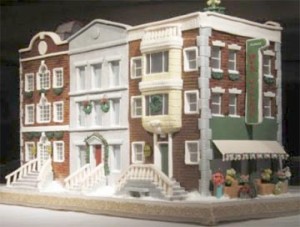History about Gingerbread
Interesting History about Gingerbread
Christmas Gingerbread house
Call 24/7 866-396-8429
This following information was compiled from a variety of resources and compiled over the decades. Very interesting facts and history on Gingerbread. More information will be updated in the future; continue checking back for updated information. If you have any further History to share, please 866-3964829 Gingerbread Bakery USA. Thank you!
Interesting Facts about Gingerbread
Gingerbread is a sweet food-product flavored with ginger and typically using honey or molasses rather than just sugar. Gingerbread foods vary, ranging from a soft, moist loaf cake to something close to a ginger biscuit. The different types likely share a common origin and taste.
Originally, the term gingerbread referred to preserved ginger. It then referred to a confection made with honey and spices. Gingerbread is often used to translate the French term pain d’épices (literally “spice bread”) or the German term Lebkuchen or Pfefferkuchen (pepperbread, literally: pepper cake). The term Lebkuchen is unspecified in the German language. It can mean Leben (life) or Laib (loaf), while the last term comes from the wide range of spices used in this product.
Gingerbread was brought to Europe in 992 by the Armenian monk Gregory of Nicopolis (Gregory Makar) (Grégoire de Nicopolis). He left Nicopolis Pompeii, to live in Bondaroy (France), near the town of Pithiviers. He stayed there seven years, and taught gingerbread baking to French Christians. He died in 999.
During the 13th century, gingerbread was brought to Sweden by German immigrants. In 15th century Germany, a gingerbread guild controlled production. Early references from the Vadstena Abbey show how the Swedish nuns were baking gingerbread to ease indigestion in 1444. It was the custom to bake white biscuits and paint them as window decorations.
The first documented trade of gingerbread biscuits dates to the 17th century, where they were sold in monasteries, pharmacies and town square farmers’ markets. In Medieval England gingerbread was thought to have medicinal properties. One hundred years later the town of Market Drayton in Shropshire, UK became known for its gingerbread, as is proudly displayed on their town’s welcome sign. The first recorded mention of gingerbread being baked in the town dates back to 1793; however, it was probably made earlier, as ginger was stocked in high street businesses from the 1640s. Gingerbread became widely available in the 18th century.
In England, gingerbread may refer to a cake, or a type of cookie/biscuit made with ginger. In the biscuit form, it commonly takes the form of a gingerbread man. Gingerbread men were first attributed to Queen Elizabeth I, who allegedly served the figurines to foreign dignitaries. Today, however, they are generally served around Christmas.
Parkin is a form soft gingerbread cake made with oatmeal and treacle which is popular in northern England.
In the United States, this form of gingerbread is sometimes called “gingerbread cake” or “ginger cake” to distinguish it from the harder forms. French pain d’épices is somewhat similar, though generally slightly drier, and involves honey rather than treacle. Original French gingerbread did not contain ginger.
In Germany gingerbread is made in two forms: a soft form called Lebkuchen and a harder form, particularly associated with carnivals and street markets such as the Christmas markets that occur in many German towns. The hard gingerbread is made in decorative shapes, which are then further decorated with sweets and icing. The tradition of cutting gingerbread into shapes takes many other forms, and exists in many countries, a well-known example being the gingerbread man. Traditionally, these were dunked in port wine.
In the Nordic countries, the most popular form of ginger confection is the pepperkaker (Norwegian), pepparkakor (Swedish), brunkager (Danish), piparkökur (Icelandic), piparkakut (Finnish) and in the Baltic countries piparkūkas (Latvian) or piparkoogid (Estonian). They are thin, very brittle cookies / biscuits that are particularly associated with the extended Christmas period. In Norway and Sweden, pepperkaker/pepparkakor are also used as window decorations, the pepperkaker/pepparkakor are then a little thicker than usual and decorated with glaze and candy. Many families bake pepperkaker/pepparkakor/brunkager as a tradition with their kids. In English, pepperkaker/pepparkakor/brunkager would be referred to as ginger biscuits rather than gingerbread.
In Switzerland, a gingerbread confection known as “biber” is typically a three-quarter inch thick rectangular gingerbread cake with a marzipan filling. Biber are famously from the cantons of Appenzell or St. Gallen and respective biber are artfully adorned with images of the Appenzell bear or the St. Gallen cathedral by engraving or icing.
In the Netherlands and Belgium, a soft and crumbly gingerbread called Peperkoek, Kruidkoek or Ontbijtkoek is popularly served at breakfast time or during the day, thickly sliced and often with butter on top.
Gingerbreads are known in Russia. The most famous gingerbreads there are baked in the ancient cities Tula (Tula gingerbread, Тульский пряник), Vyazma, and Gorodets.
In Poland, gingerbreads are known as pierniki (singular, piernik). The most famous are called Toruń gingerbread (piernik toruński), a traditional Polish gingerbread that has been produced since the Middle Ages in the city of Toruń. It was a favorite delicacy of Chopin‘s when he visited his godfather, Fryderyk Florian Skarbek, in Toruń during one of his school vacations.
In Romania, gingerbread is called turtă dulce and is usually coated with sugar glazing.
In Brazil, a type of cake similar to gingerbread is known as pão de mel (“honey bread”), it can be as big as a coffee cake, or bite-sized, and it’s usually coated with chocolate.
There is also a very popular local variety of gingerbread in Bulgaria. It’s called меденка (“made of honey”). Traditionally the cookie is as big as the palm of the hand, round and flat, covered in a thin layer of chocolate. Other common ingredients include honey, cinnamon, ginger and dried clove. It is also made in Karakol.








